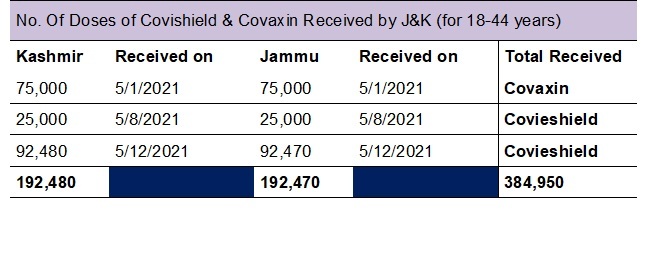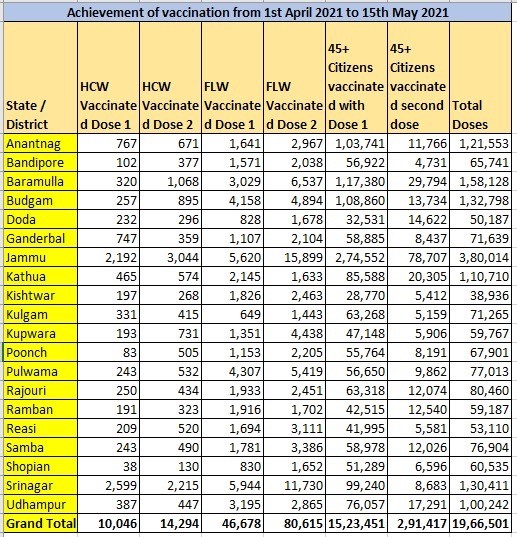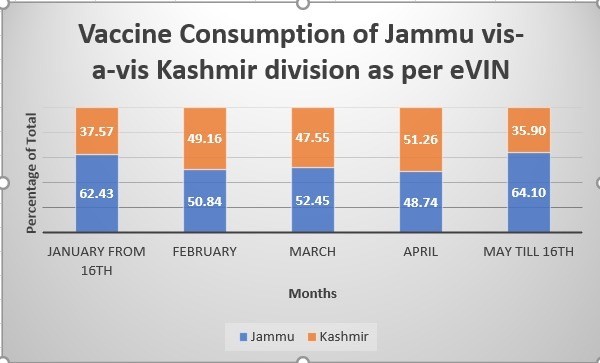
KO File Photo By Abid Bhat
Despite equal amount of vaccine doses for Jammu & Kashmir, the government says, the people in Kashmir valley were reluctant to get vaccinated.
SRINAGAR- After drawing flak for “unequal dose distribution and vaccine shortage” in the Kashmir valley, the government on Monday blamed the jab hesitancy for Kashmir’s slow rate.
The government clarified its stand a day after social media users in Kashmir rolled up their sleeves in anticipation of people getting Covid jab: “Where’re the vaccines?”
While the government officials have assured that supply will become regular in a day or two, the official documents reveal how vaccine hesitancy in Kashmir division has been replaced by desperation.
“Despite having received almost similar amount of vaccine doses as winter capital Jammu, the immunisation programme was a tough challenge for medical fraternity in Kashmir valley owing to rumours and fake news on Social Media,” a top government official presiding over the vaccine program told Kashmir Observer.
Since 16 January 2021, the official informed, Jammu and Kashmir had received 38,73,360 doses of Covishield and Covaxin.
“Of the total, 19,02,220 were meant for Kashmir Division and 19,71,140 for Jammu Division,” reveal the government documents shared by the official.

Jammu and Kashmir, according to May 15 data, has achieved vaccination coverage of 61.03% against the national average of 32.17%.
“It’s a huge achievement for the J&K,” the official who insisted not to be named claimed.
But, scratch the surface and these documents unravel other intriguing facts.
The summer capital Srinagar, which started vaccination drive at the same time as Jammu, have clocked only 35.52% coverage of the priority group while the latter has achieved 98.48% vaccination.

“Another district Kupwara in Kashmir division has achieved merely 27.57% while the worst performing district of Doda in Jammu Division managed to score 46.04%,” the official documents in possession of Kashmir Observer reveal.
“Just before the second wave hit the country, same social media warriors in the valley were burning midnight oil to discredit the efficacy of vaccine and entire immunisation programme,” the official said.
“Nevertheless, religious leaders, influencers and authorities tried to persuade the people to get vaccinated. The efforts paid dividends and many districts like Ganderbal, Shopian crossed 90% while other districts like Kulgam, Bandipora, Anantnag, Baramulla, Budgam did fairly well in the immunisation drive.”
Vaccine Hesitancy In Kashmir
The World Health Organisation 11-pages power point presentation on Covid-19 vaccination defines vaccine hesitancy as a “delay in acceptance or refusal of vaccines despite availability of vaccination services” and it is “influence by factors such as complacency, convenience and confidence”, another senior government official said.
“In Jammu & Kashmir, particularly in Kashmir division vaccine hesitancy model added other factor- rumours,” he said.
“Complacency, convenience and confidence garnished by rumours not only delayed vaccination drive in Kashmir division in comparison to Jammu but also put additional burden on authorities to mount a campaign roping in mass media, influencers, religious leaders to get the jab to protect themselves and their family members.”

Official documents reveal that between January 16 to March 31, 2021, Srinagar district registered 13,152 vaccinations of 45 and above citizens. During the same period Jammu district’s figure was 90,515.
“Between April 1 to May 15, 2021, Srinagar clocked 99,240 vaccinations while data from Jammu shows remarkable progress with 2,74,552 Covid doses to citizens above 45,” the data shows.
“This excludes the health care workers and front line warriors. Even in March when the people were persuading the citizens, the health officials were perplexed that stocks were lying unused in Kashmir Division while citizens in Jammu were getting jabbed.”
A government official said in the first week of March religious leaders were roped in to persuade the people in Kashmir division.
“Women doctors were advising the womenfolk not pay to heed to the rumours that Covid vaccine causes infertility. On March 10, the total availability of vaccine in Kashmir Division was 10,19,000 while in Jammu total available doses were 7,92,000.
“Doctors were scared what to do with 10 Lakh plus doses when people were reluctant. The surge in Kashmir division vaccination drive came only after April 15 while Jammu’s performance was as steady. This is the reason why Jammu could last for few extra days beyond May 13. The April surge could be attributed to twin factor- appeal from top religious leaders and growing awareness among the masses about threat from mutant virus,” the official said.

Blaming some media outlets and social media users for misleading the public about dose shortage, the official said, “They conveniently buried the data which was already in the public domain. There was no discrepancy in distribution of Covid vaccine doses but initial vaccine hesitancy at local level in Kashmir division. Despite that our UT average is better than the national average and many other states.”

Even in Medical Health Infrastructure, J&K today has 47 Oxygen Plants, he said. “14 more will become operational within this month and in the next 6-month, we will have 99 Oxygen plants.”
And as far as vaccine is concerned, the official said, within a day or two, “we will receive the consignment. I urge everyone to get vaccinated. Our top most priority is to vaccinate entire population of the priority group within 10 days.”
Follow this link to join our WhatsApp group: Join Now
Be Part of Quality Journalism |
Quality journalism takes a lot of time, money and hard work to produce and despite all the hardships we still do it. Our reporters and editors are working overtime in Kashmir and beyond to cover what you care about, break big stories, and expose injustices that can change lives. Today more people are reading Kashmir Observer than ever, but only a handful are paying while advertising revenues are falling fast. |
| ACT NOW |
| MONTHLY | Rs 100 | |
| YEARLY | Rs 1000 | |
| LIFETIME | Rs 10000 | |













